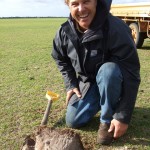Case Studies in South Coast WA
Case Study
Case studies have been written on many farmers putting EverGraze principles into practice. The pages below provide stories from farmers in the south coast WA region describing what changes they have made to their farming enterprises and the impact on their business and lifestyle.
| Site location | Host producer | Title | Focus |
| Woogenellup | Barry and Geanie Pearce | Perennials lift carrying capacity – Barry and Geanie Pearce | In this financial case study, Barry and Genie Pearce of Woogenellup, WA, look at the production and financial benefits of a lucerne and fescue mix versus annual pasture. |
| Woogenellup | Barry and Geanie Pearce | Perennials address salinity, water logging and summer feed shortage | Barry and Genie Pearce have a property at Woogenellup, 70 kms north of Albany in WA. They host an EverGraze Supporting Site which is looking at perennials to address salinity and waterlogging whilst also increasing summer forage production. |
| Kojonup | Daniel and Narelle Simpson | Kikuyu provides flexible grazing for sheep south-west of Kojonup – Daniel and Narelle Simpson | Daniel and Narelle Simpson were interested in achieving extra feed during summer – autumn to reduce hand feeding to sheep. In this financial case study, the production and financial benefits of the kikuyu have been compared with one of the better annual pastures on the farm. |
| Esperance | Erica Ayers & Phil Cleghorn | Kikuyu holds it all together – Erica Ayers & Phil Cleghorn | Erica Ayres and Phil Cleghorn have a 1280ha property at Esperance, WA. Farming on a coastal sandplain in Western Australia can have its challenges, but kikuyu is helping provide some solutions. Kikuyu provides year-round groundcover on fragile sandy coastal soils. |
| Esperance | Erica Ayers & Phil Cleghorn | Kikuyu for summer production in WA – Erica Ayers & Phil Cleghorn | Erica and Phil farm a property 25-30kms north east of Esperance on typical sand plain soils. They host an EverGraze Supporting Site which has annual pastures, kikuyu and crops on the property and a mix of sheep and cattle. They have been increasing their area of kikuyu pastures over the last eight years. |
| Manjimup | John, David and Danielle Mottram | Tall fescue benefits beef cattle near Manjimup – David, John and Danielle Mottram | David, John and Danielle Mottram farm south east of Manjimup in WA. In this financial case study, the production and financial benefits of the tall fescue have been compared with annual pastures of predominantly sub clover and annual ryegrass. |
| Oyster Harbour Catchment | Kelvin and Estelle Ridgeway | Winter active tall fescue boosts stocking rates and farm profits – Kelvin and Estelle Ridgeway | Kelvin and Estelle Ridgway run sheep for prime lamb production, beef cattle integrated with contract grass seed production. They were looking for a perennial that would provide increased feed during autumn. This financial case study looks at the costs and benefits of growing tall fescue versus their existing annual pasture. |
| Gnowellen | Morgan and Debbie Sounness | Superfine wool on kikuyu in WA – Morgan and Debbie Sounness | Morgan and Debbie Sounness farm a 1277ha property on the sand plain east of Albany, WA near Wellstead. They have a mixed enterprise of cropping (130ha oats) and 5000+ sheep with a big focus on superfine wool, which has progressed along with their use of kikuyu. They have also developed a kikuyu seed production business which is one of only two businesses producing seed in Australia. |
| Esperance | Phil Cleghorn and Erica Ayers | Kikuyu for feed and control of wind erosion – Phil Cleghorn and Erica Ayers | Erica Ayers and Phil Cleghorn farm a property 25-30kms north east of Esperance on typical sand plain soils. A discounted cash flow analysis of kikuyu versus annual pasture was performed with three scenarios. |
| Kojonup | Thys and Erin Gorter | Pairing perennials proves profitable – Thys and Erin Gorter | The success Erin and Thys Gorter are having with their lucerne and chicory combination is thanks to the couple’s strong focus on grazing management. The decision was made to sow lucerne basically because a legume was needed to feed the chicory. |
| Kojonup | Thys and Erin Gorter | Backgrounding lambs on chicory/lucerne pastures at Kojonup – Thys and Erin Gorter | On Erin and Thys Gorter’s farm, the production and financial benefits of the chicory/lucerne mix have been compared with that from an annual pasture on the farm. The annual pastures include predominantly sub clover and annual ryegrass with varying amounts of broadleaf and grass weeds. |




